After using my third pair of Merrell Moab shoes for more than four years, I decided to cut them through and to see what is inside. Here you can see it now yourself.
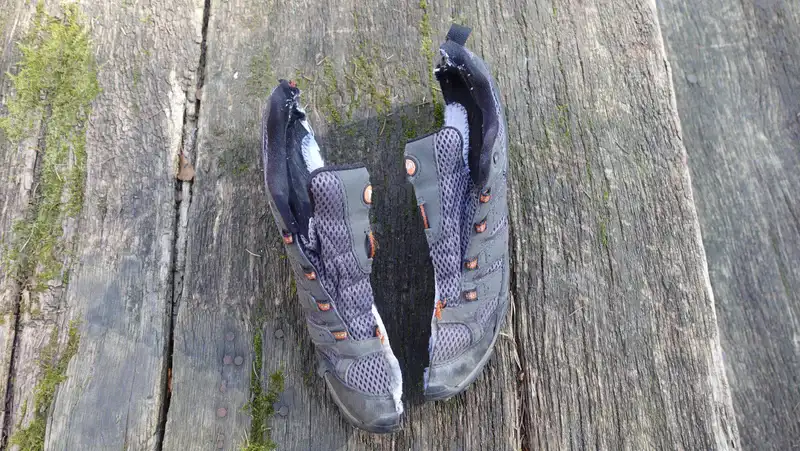
For outdoor enthusiasts, the Merrell Moab has long been a go-to choice for hiking shoes, blending durability, comfort, and weather resistance into a reliable package. Since its introduction, the Moab line has earned a loyal following, with millions of pairs sold worldwide.
As a fan of the Moab myself, and having owned three pairs since my first in 2008, I recently decided to take a closer look at what makes these shoes tick.
Specifically, I wanted to understand why the Gore-Tex membrane, a hallmark of the Moab’s waterproofing, sometimes fails over time. But this is not only about Moab, and not only about shoes or boots. The same is with all my “waterproof” equipment, boots, jackets, pants.
So, I took a pair of my old, worn-out Moabs and cut them open to reveal their inner workings. This gave me some insights into the construction of these iconic shoes.
A Brief History of the Merrell Moab
Merrell, a brand founded in 1981 by Clark Matis, Randy Merrell, and John Schweizer, initially focused on crafting high-quality hiking boots and shoes.
The company quickly gained a reputation for rugged, reliable footwear, and by the early 2000s, Merrell was ready to expand its offerings.
The Merrell Moab, first introduced in 2007, was designed as a versatile hiking shoe that could handle a variety of terrains while keeping feet dry and comfortable. Named after the Moab Desert in Utah, a region known for its challenging trails and extreme weather, the shoe was an instant hit among hikers, backpackers, and outdoor adventurers.
The Moab’s success can be attributed to its thoughtful design: a Vibram sole, a cushioned midsole for comfort, and, most notably, a Gore-Tex membrane for waterproofing and breathability. But note that they also have their Ventilator version which is without the membrane, this was my first pair.
Since its launch, the Moab has become one of Merrell’s best-selling models. While exact sales figures are proprietary, industry estimates suggest that by 2025, Merrell has sold over 25 million pairs of Moab shoes globally, a testament to their enduring popularity.
My own journey with the Moab began in 2008, just a year after its debut, and over the years, I’ve worn through three pairs.
Cutting Open the Moab: What’s Inside?
After years of use, my most recent pair of Moabs had reached the end of their life. The tread was worn, the upper was fraying, and, most disappointingly, they were no longer waterproof despite the Gore-Tex label.
Curious to understand why, I decided to dissect the shoe, slicing through the midsection to reveal its internal structure.
At the outermost layer is the shoe’s upper, a combination of leather and synthetic mesh designed for durability and breathability.
Beneath that lies the Gore-Tex membrane, a thin, white layer sandwiched between the outer material and the inner lining.
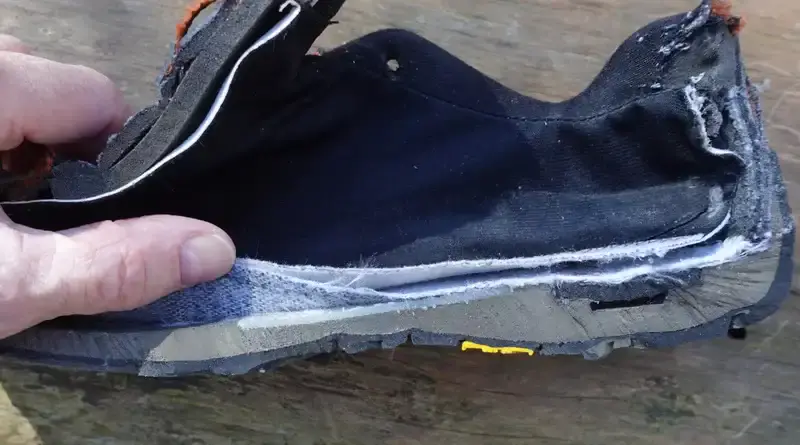
Gore-Tex, a technology developed in 1976 by W.L. Gore & Associates, is a polytetrafluoroethylene (PTFE) membrane with microscopic pores, small enough to block water droplets but large enough to allow water vapor (sweat) to escape. This makes it ideal for outdoor footwear, as it is supposed to keep feet dry from external moisture while preventing a sweaty, clammy feeling inside the shoe.
To my surprise, in the cross-section, the Gore-Tex membrane appeared intact after all these years, the picture below.
Below the Gore-Tex layer was the inner lining, a fabric meant to provide comfort against the foot, followed by a foam midsole for cushioning and support.
At the bottom was the Vibram outsole, still showing remnants of its lugs despite heavy wear.

Why Does Gore-Tex Stop Being Waterproof?
The primary reason I cut open my Merrell Moabs was to understand why the Gore-Tex membrane had failed to keep my feet dry.
Over time, I noticed that water would seep into the shoes during wet hikes, a frustrating issue for a shoe marketed as waterproof. However, from the cross-section, I could not really have an answer. It looked pretty much in a good state.
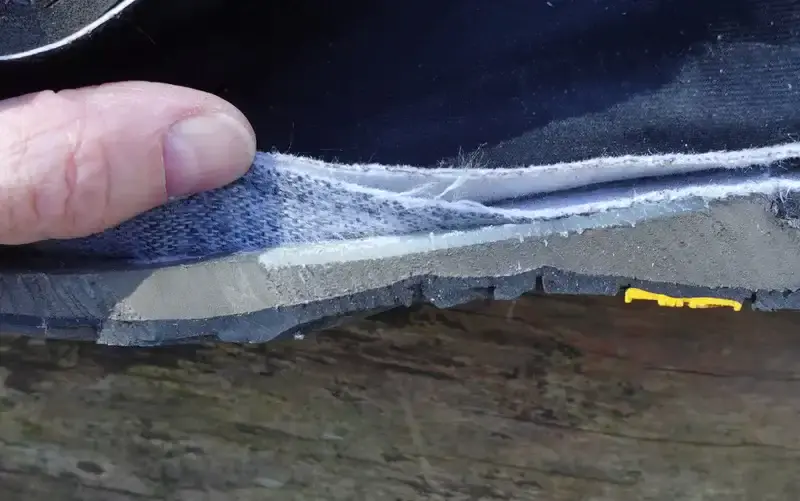
But here is what I find when reading some articles online:
Delamination and wear: The Gore-Tex membrane relies on being securely bonded to the surrounding materials. In time, the membrane may start to peel away from the outer layer and inner lining, due to repeated flexing, exposure to moisture, and the natural breakdown of adhesives over time.
Once delamination occurs, water can bypass the membrane, entering the shoe through gaps between the layers.
Dirt and contamination: Gore-Tex’s breathability depends on its pores remaining open. However, dirt, sweat, and oils from the foot can clog these pores, reducing breathability and causing moisture to build up inside the shoe.
In some cases, this can also compromise the membrane’s ability to repel water, as contaminants may create pathways for water to penetrate.
Physical damage: While the Gore-Tex membrane itself is durable, it is not immune to damage. Small tears or punctures, whether from sharp rocks, thorns, or even internal wear from the foot, can create entry points for water.
In my cross-section, I could not really notice tear in the membrane near, but perhaps it is hard to spot by naked eyes. It may be caused by the shoe’s flexing over thousands of steps.
Aging materials: Over time, the materials surrounding the Gore-Tex membrane degrade. The outer layer of my Moabs had worn thin in spots, and the inner lining was frayed.
This wear exposes the membrane to more stress and reduces its effectiveness, as the surrounding layers no longer provide adequate protection.
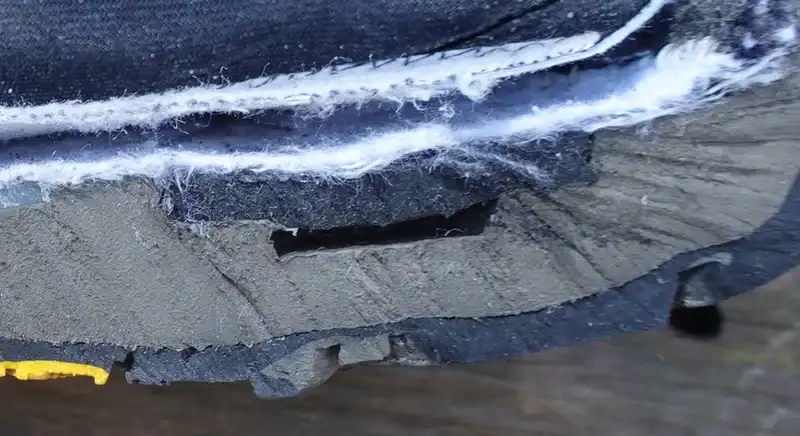
Tips for Prolonging Gore-Tex Performance
Cutting open my Merrell Moabs revealed the complexity of their construction and the challenges of maintaining waterproofing in a shoe that is subjected to harsh conditions.
While Gore-Tex is an impressive technology, it is not invincible, and its performance depends on the overall health of the shoe.
Here are a few tips I have learned from reading around to help extend the life of Gore-Tex footwear:
Clean regularly: After every hike, clean your shoes to remove dirt and debris that can clog the Gore-Tex membrane. Use a soft brush and lukewarm water, and avoid harsh detergents that can damage the membrane.
Dry properly: Never dry your shoes near a heat source like a radiator or campfire, as high heat can weaken the adhesives holding the Gore-Tex layer in place.
Instead, let them air dry at room temperature, stuffing them with newspaper to absorb moisture.
Reapply waterproofing treatments: Over time, the durable water repellent (DWR) coating on the outer layer of the shoe wears off. Reapplying a DWR spray can help restore the shoe’s ability to repel water, reducing the burden on the Gore-Tex membrane.
Inspect for damage: Regularly check your shoes for signs of wear, such as fraying seams or thinning material. Addressing these issues early, perhaps with a patch or sealant, can prevent further damage to the Gore-Tex layer.
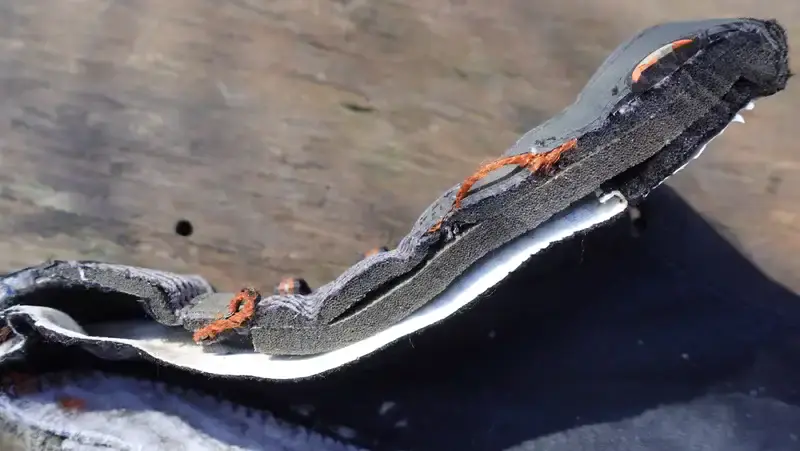
Please see more in my video:
The Legacy of the Merrell Moab
The Merrell Moab remains a beloved choice for hikers nearly two decades after its introduction. Its combination of comfort, durability, and weather resistance has made it a staple on trails around the world, with millions of pairs sold since 2007.
While cutting open my old pair revealed the potential for vulnerabilities of the Gore-Tex membrane, it also deepened my appreciation for the engineering that goes into these shoes.
If you are a Moab owner, or considering becoming one, understanding the inner workings of the shoe can help you get the most out of your investment.
With proper care, the Merrell Moab can keep your feet dry and comfortable for many miles. And if, like me, you ever find yourself wondering what’s inside, a quick dissection might just satisfy your curiosity, though I would recommend waiting until the shoes are well past their prime!
Thank you for reading. Let me know if you have questions or comments, there is a comment box below. Subscribe to my weakly newsletter and stay informed, the subscription form is given below.
Leave a Reply